

SCAT and its Specialist Calculators


How a start-up company formed by a group of friends developed a successful series of advanced specialist calculators.
Grateful thanks to Joe Rogers who has very generously provided the information for this article.
South Carolina Applied Technology and its Specialist Calculators
The company was started by John Watkins, my partner in an architectural firm in Columbia, South Carolina, my friend Billy Timmons, who at that time was working as a civil engineer at a firm in Columbia, and me.
Billy and I were from the same home-town (Manning, SC) and ran into each other in Columbia a few years out of college. We were having lunch one day and decided that we needed to get in on the technology revolution, since Billy and I are both frustrated inventors. John said that if we could figure out how to make a calculator that did math in feet and inches he'd buy one. That's what started the company.
We designed the calculator around the National Semiconductor "COPS" chip - a 4 bit microcomputer which at that time was mostly used to run the Mr. Coffee coffee makers. We used an EPROM (Erasable Programmable Read-Only memory) chip to store the programs on the prototypes, which were (and continued to be) really very small computers.
Billy wrote the code - it was all binary - and I dealt with the hardware. Billy would sketch out the circuits and I would make them out of hobby kits we bought at Radio Shack. When we finally got to a production version we were having the PC boards made by a firm in Virginia. The cases were injection moulded at a small plant in Anderson, SC, and the first few hundred were made by Billy and me on a card table in a spare room at my architectural firm. We eventually made most of the production (I think we made and sold about ten or twelve thousand of them) in a garage in the Home Branch area of South Carolina. It was where Billy lived, and we set up production in his garage.
The cases were designed by Jose Suarez, one of the architects at our firm. I had hired him right out of architecture school and he and I are still very close friends. Jose's first design was very sleek - we called it "the tank" because it looked a little like a WWI tank (see the photograph below).
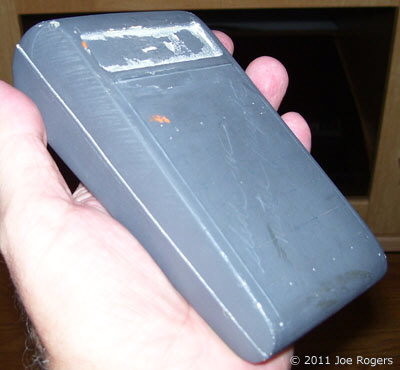
"The tank" case prototype.
We eventually went with the version shown in the photograph of "The Dimension" (below) which was Jose's second or third design, and I can't really remember why, but I think it had to do with the cost of making the injection molds. We had looked everywhere for an off the shelf case, but none looked like we wanted the device to look, so we spent about $50,000 to have our own tooling made.
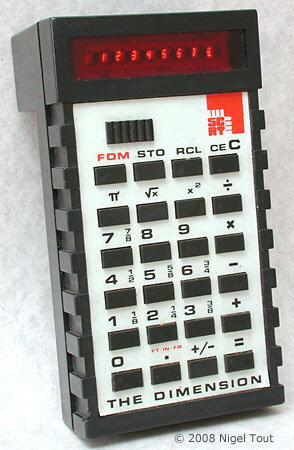
The final design of case for the SCAT calculators, here shown in "The Dimension" feet & inches model.

In the photograph above you can see a progression of prototypes, including one of the earliest functional ones with the "Bruning" label on it. We had tried to sell the idea to several large companies and Bruning came close to buying, but in the end one or more of them took the idea and went elsewhere with it - which happened with the "Solution" model as well.
Yes, the "Bruning" prototype had cardboard and electrical tape sides! We used cannibalised Texas Instruments calculators for the cases for our early prototypes to avoid having to design our own keyboards. We later used custom made membrane key-switches for our keyboards.
Versions we sold were:
- The Dimension - Feet & inches calculator.
- the solution - calculates compositions of chemical solutions and dilutions.
- Metalmate - quick calculation of bulk metals such as steel coils, bars, tubes, etc., for the wholesale metals industry
- GA-22 Graphic Arts calculator - does math in printers units: points, picas, etc.
One that we developed but never sold was designed to carry out a statistical calculation based on an article we found in the New England Journal of Medicine, about a mathematical calculation of the probability of a patient having a heart attack, based on yes/no answers to a series of questions. The idea was that the indicators produced by the answers to these questions were so strong that their use by an emergency physician would help make a rapid but accurate decision about whether or not a patient was, in fact, having a heart attack. We had contacted the researcher and entered an agreement to sell the device to hospitals when our outside investors (we had had to sell most of the company by then) refused to accept the potential liability of a lawsuit in the case of a mis-diagnosis and decided we wouldn't market the product.
© 2011 Joseph O. Rogers III/ Nigel Tout
This is a new article which was not originally in "The International Calculator Collector".
The
Dimension and the solution are Featured Hand-held Calculators.
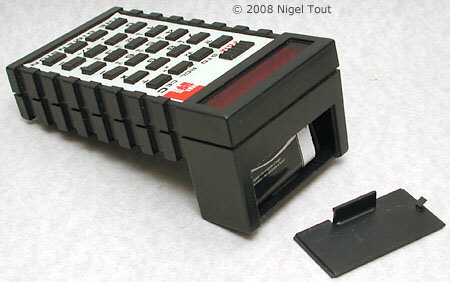
As well as a futuristic look the SCAT calculator case has an unusual shape with a bulge at the back for the battery compartment, though this allows the calculator to sit at a good viewing angle on a desk.
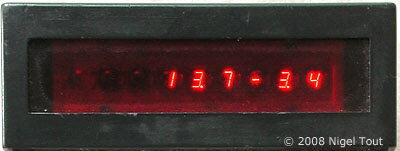
Clever use of the 8-digit LED display was needed to display feet & inches.
Here the display shows 13 feet 7 3/4 inches.
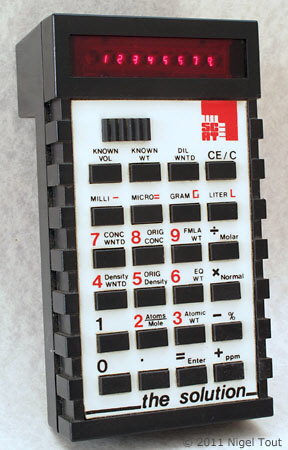
"the solution" model which calculates compositions of chemical solutions and dilutions.
Calculator Articles
Vintage Calculators
Text & photographs copyright, except where stated otherwise, © Nigel Tout 2000-2026.